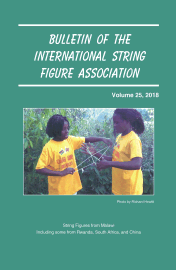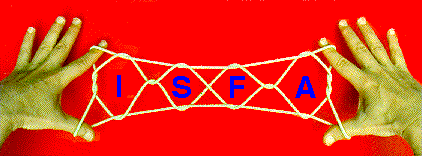Articles de isfa
-
Volume 25 (2018): 221 pages - Table des Matières
- Par isfa
- Le 20/07/2019
- Dans Bisfa 25
- 0 commentaire
Edité par - Mark A. Sherman, Pasadena, California
Rédacteurs Associés - Joseph D'Antoni, Queens, New York; Myriam Namolaru, Haifa, Israel;
Belinda Holbrook, Davenport, Iowa; Stephan Claassen, Best, Netherlands.
Comité de Rédaction - Hiroshi Noguchi, Tokyo, Japan; Philip Noble, Inverness, EcosseLe Bulletin de l'Association Internationale du Jeu de Ficelle (BISFA) est une publication savante
présentant des documents originaux qui fait progresser notre compréhension et renforce
notre plaisir des jeux de ficelle. BISFA est publié annuellement, en septembre, par ISFA Press
(Pasadena, Californie). BISFA remplace le Bulletin de l'Association des Jeux de Ficelle,
(Toky Nippon Ayatori Kyokai), qui a été publiée en 19 volumes (1978-1993).
Les traductions proposées ne comprennent pas les illustrations et photos du texte original.
J'ai traduit ces textes pour vous donner un aperçu de la qualité et de la richesse de
ces publications.

Special Issue: String Figures from Malawi - including some from Rwanda, South Africa, and China
- The String Figures of Malawi by Martin Probert, Alisoun Probert, UK, Richard Hewitt, Samson Phiri, Malawi (pages 1-208) - String figure making is alive and well in Malawi. There is an evolving repertoire of figures named after everyday twenty-first century objects. Highly sophisticated manipulations appear in a number of figures. One hundred and fifteen informants contributed to this 2016-2018 study in which excursions were made to different parts of Malawi, 397 movies made, dozens of photographs taken, six exhibitions held, and detailed interviews recorded with eleven of the informants. Eighty-six string figures were obtained, together with an additional ten minor variants, and a further five figures which appeared under a different name and interpretation. Of the eighty-six figures, eighty have not been recorded in Africa outside Malawi. The collection contains much unique, innovative material. One of the figures might be a survival from the msondo (girls’ initiation ritual). The informants, one-hundred-and-one female and fourteen male, aged 6 to 60, have been born in, or educated in, 25 of the 28 districts in Malawi. The collection has distinctive features: (i) over two-fifths of the figures are based upon a technique referred to here as the Chishango-technique; (ii) eleven figures represent letters of the alphabet; (iii) almost a third of the figures are derived from ingenious transformations of other Malawian figures.
- Six Rwandan String Figures by Martin Probert, UK, Richard Hewitt, Samson Phiri, Chikondi Medson, Malawi (pages 209-217) - Six Rwandan string figures are collected in 2017 from Aissa Ruberintwari, a pupil of Kamuzu Academy, Mtunthama, Kasungu, Malawi. One of the figures, Rwanda #5, is not known from any previous African collection.
- Two South African String Figures by Martin Probert, UK, Richard Hewitt, Samson Phiri, Malawi (pages 218-219) - These South African string figures were recorded on 3 July 2017 at the National Science Fair, Kamuzu Academy, Malawi.
- A ‘New’ Chinese String Figure by Martin Probert, UK, Richard Hewitt, Samson Phiri, Malawi (pages 220-221) - This string figure, although well-known around the world, has not previously appeared in BISFA articles on the string figures of China.


